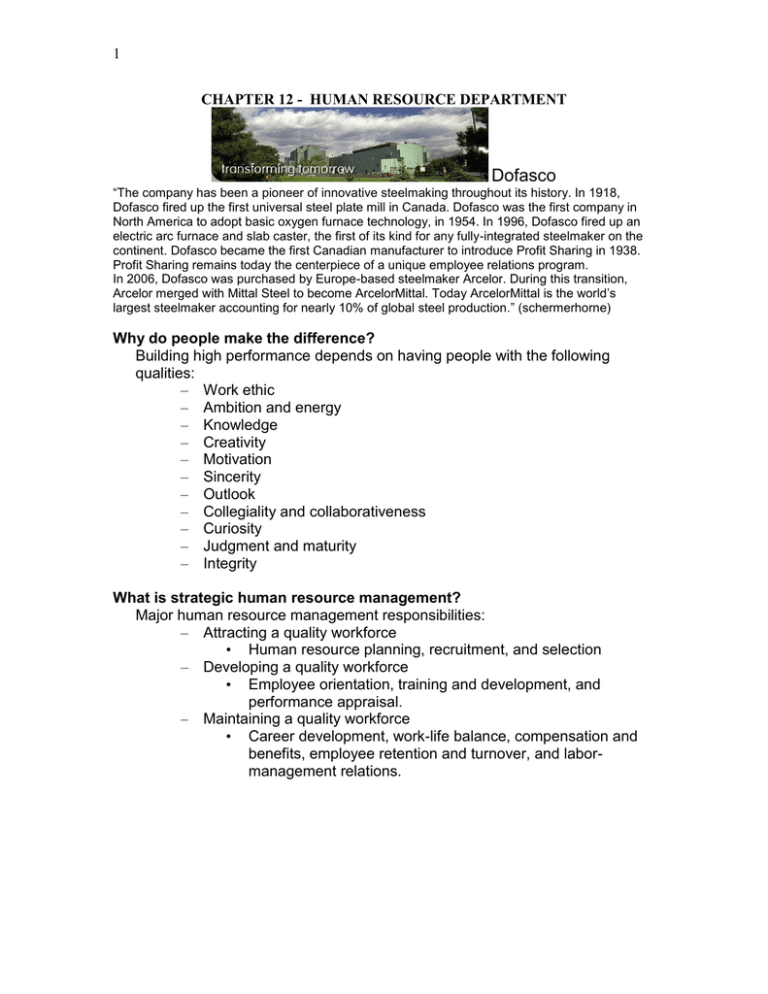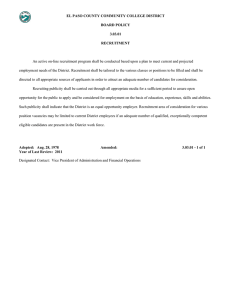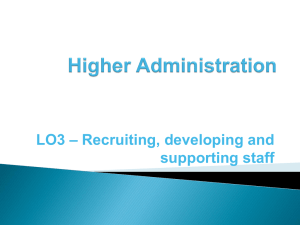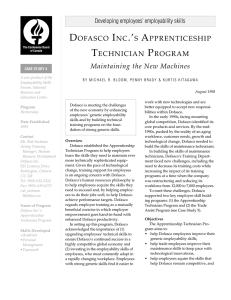
1
CHAPTER 12 - HUMAN RESOURCE DEPARTMENT
Dofasco
“The company has been a pioneer of innovative steelmaking throughout its history. In 1918,
Dofasco fired up the first universal steel plate mill in Canada. Dofasco was the first company in
North America to adopt basic oxygen furnace technology, in 1954. In 1996, Dofasco fired up an
electric arc furnace and slab caster, the first of its kind for any fully-integrated steelmaker on the
continent. Dofasco became the first Canadian manufacturer to introduce Profit Sharing in 1938.
Profit Sharing remains today the centerpiece of a unique employee relations program.
In 2006, Dofasco was purchased by Europe-based steelmaker Arcelor. During this transition,
Arcelor merged with Mittal Steel to become ArcelorMittal. Today ArcelorMittal is the world’s
largest steelmaker accounting for nearly 10% of global steel production.” (schermerhorne)
Why do people make the difference?
Building high performance depends on having people with the following
qualities:
– Work ethic
– Ambition and energy
– Knowledge
– Creativity
– Motivation
– Sincerity
– Outlook
– Collegiality and collaborativeness
– Curiosity
– Judgment and maturity
– Integrity
What is strategic human resource management?
Major human resource management responsibilities:
– Attracting a quality workforce
• Human resource planning, recruitment, and selection
– Developing a quality workforce
• Employee orientation, training and development, and
performance appraisal.
– Maintaining a quality workforce
• Career development, work-life balance, compensation and
benefits, employee retention and turnover, and labormanagement relations.
2
Discrimination in employment
– Occurs when someone is denied a job or job assignment for
reasons that are not job relevant.
Employment equity
– An effort to give preference in employment to Aboriginals, women,
visible minorities, and people with physical/mental disability.
– Bona fide occupational requirements are employment criteria
justified by the capacity to perform a job.
Current legal issues in HR management
– Sexual harassment is behaviour of a sexual nature that affects a
person’s employment situation
– The Canadian Human Rights Act and the procedures and the
Canada Labour Code protect employees from sexual harassment
in the workplace
How do organizations attract a quality workforce?
The foundation of human resource planning is job analysis.
– The orderly study of job facts to determine just what is done, when,
where, how, why, and by whom in existing or potential new jobs.
Job analysis provides information for developing:
– Job descriptions
– Job specifications
Recruitment
– Activities designed to attract a qualified pool of job applicants to an
organization.
– Steps in the recruitment process:
• Advertisement of a job vacancy.
• Preliminary contact with potential job candidates.
• Initial screening to create a pool of qualified applicants.
Recruitment methods:
– External recruitment — candidates are sought from outside the
hiring organization.
– Internal recruitment — candidates are sought from within the
organization.
– Traditional recruitment — candidates receive information only on
most positive organizational features.
– Realistic job previews — candidates receive all pertinent
information.
3
Selection
– Choosing from a pool of applicants the person or persons who offer
the greatest performance potential.
Selection Steps
– Completion of a formal application form.
– Interviewing.
– Testing.
– Reference checks.
– Physical examination.
– Final analysis and decision to hire or reject.
Step 1—application forms
– Declares individual to be a job candidate.
– Documents applicant’s personal history and qualifications.
– Personal résumés may be included.
– Applicants lacking appropriate credentials are rejected at this step.
Step 2—interviews
– Exchange of information between job candidate and key members
of the organization.
– Opportunity for job candidate and organizational members to learn
more about each other.
Step 3 — employment tests
– Used to further screen applicants by gathering additional jobrelevant information.
– Common types of employment tests:
Intelligence
Aptitude
Personality
Interests
Step 4 — reference and background checks
– Inquiries to previous employers, academic advisors, coworkers
and/or acquaintances regarding applicant’s:
Qualifications.
Experience.
Past work records.
– Can better inform potential employer.
– Can enhance candidate’s credibility.
Step 5 — physical examinations
– Ensure applicant’s physical capability to fulfill job requirements.
– Basis for enrolling applicant in life, health, and disability insurance
programs.
– Drug testing is done at this step.
4
Step 6 — final decision to hire or reject
– Best selection decisions will involve extensive consultation among
multiple parties.
– Selection decision should focus on all aspects of the candidate’s
capacity to perform the designated job.
Training
– A set of activities that provides the opportunity to acquire and
improve job-related skills.
On-the-job training
– Job rotation
– Coaching
– Mentoring
– Modeling
Off-the-job training
– Management development
Performance appraisal
– Formally assessing someone’s work accomplishments and
providing feedback.
– Purposes of performance appraisal:
Evaluation — lets people know where they stand relative to
objectives and standards.
Development — assists in training and continued personal
development of people.
Work-life balance
– How people balance career demands with personal and family
needs.
– Progressive employers support a healthy work-life balance.
– Contemporary work-life balance issues:
• Single parent concerns
• Dual-career couples concerns
• Family-friendliness as screening criterion used by
candidates
Compensation and benefits
– Base compensation
• Salary or hourly wages
– Fringe benefits
• Additional non-wage or non-salary forms of compensation
– Flexible benefits
• Employees can select a set of benefits within a certain dollar
amount
– Family-friendly benefits
• Help in balancing work and nonwork responsibilities
– Employee assistance programs
• Help employees deal with troublesome personal problems.






